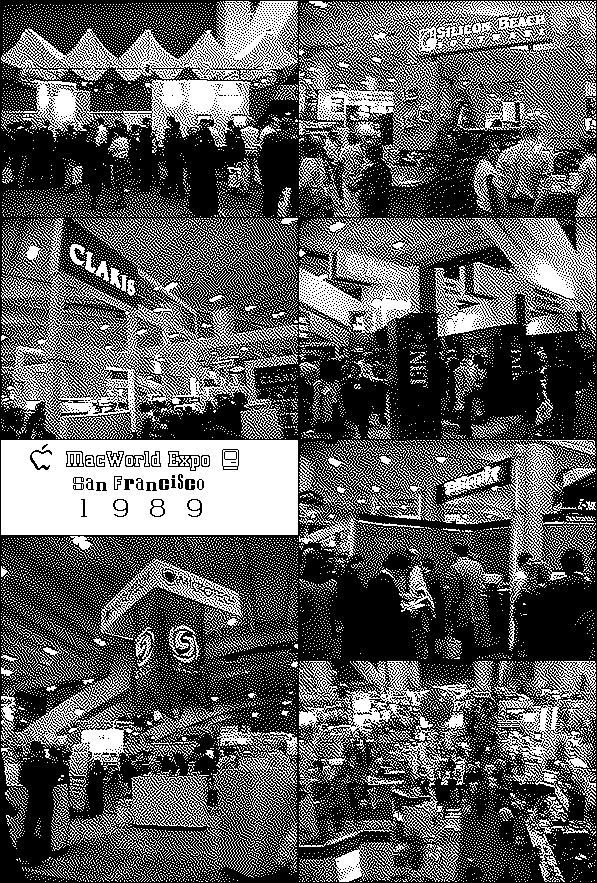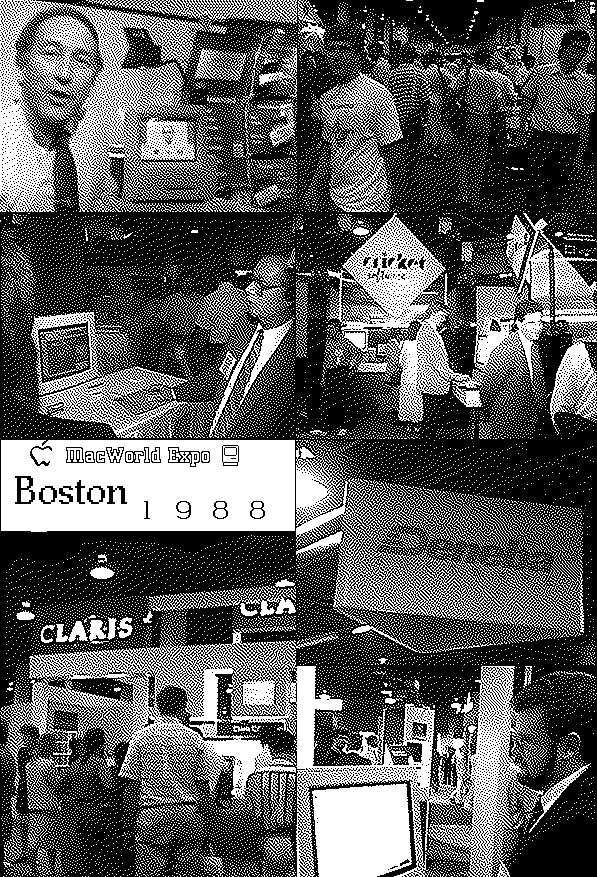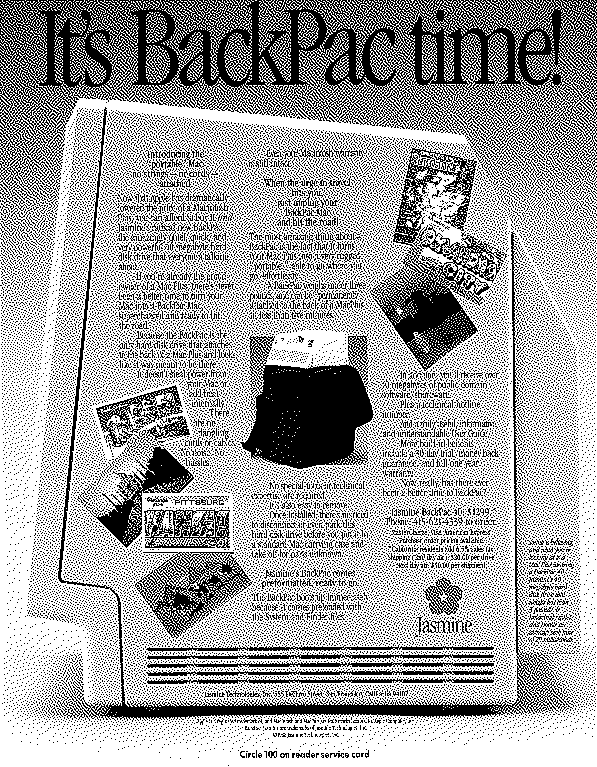Macworld Expo 1989 San Francisco
898 words
9K on disk
January 1989
 Macworld Expo 1989 San Francisco
Macworld Expo 1989 San Francisco

Dates: January 20 – 23, 1989
Cost:
Exhibitors:
Locations: Moscone Center and Brooks Hall
Attendees: 60,000
Keynote
John Sculley, “attired in faded, wrinkled corduroys and an Apple sweat shirt,” introduced the SE/30 and IIx: two new machines based on Motorola’s 68030 CPU. Sculley also showed off a Mac controlling a Videodisc player through a HyperCard stack, a project dubbed HyperTV. This demo paired an 8Mb IIx with video capture and NTSC-RGB conversion cards from AST, all controlling a Pioneer videodisc player via HyperTV XCMDs (external commands).
The NuView board takes live video signals from the videodisc, camcorder or other video source, converts them to RGB signals, converts these to digital images
Themes
Jerry Borrell, Editor-in-Cheif of Macworld first named Apple’s introduction of 030-based Macs as the most important development at the Expo. He then named four further themes that he saw at the show:
1) Communication devices (modems and networking, presumably?).
2) Color printers for “hard copy output”.
3) Color Broadcast Video peripherals
4) Accelerator cards for the Mac, “believe it or not”. This was presumably one of the first time such cards *could* be developed. Two prerequisites had been met: first, the debut of the “Open Mac” architecture of the Macintosh II a few years previously (March 1987), and secondly a processor advancement (from the 68020 that shipped in the II, to the 68030 in the IIx and SE/30.) Of course, previous closed Macs such as the Plus could be upgraded with special clip-on chips which boosted clock speeds, but 1989 was the first year that accelerators could be introduced based on the Apple-approved NuBus boards.
Another view into what this Expo was like is given by BMUG’s David Morgenstern, who highlighted the differences between the two convention locations by noting:
Moscone was filled with huger over-designed super booths…. Brooks Hall had more of the flavor of the early MacWorld Expos, “old fashioned and friendlier” were often heard comparisons. There were lots of interesting startup companies there too, with more bucks spent on the product, than the packaging.
This comparison echoes the descriptions of “TinyTown” in more recent MacWorld Expos, a term invented by Merlin Mann for the micro-booths at one end of the show floor, usually populated small/indie Mac developers.
Hardware
68030-based Macs made their debut with the Macintosh SE/30.
Both Macworld editor Borrell, as well as BMUG observer David Morgenstern, called out the Ricoh erasable magneto-optical drives on the show floor as a hardware breakthrough. This was early 1989, and the NeXT Cube, with its standard MO drive, was surely on everyone’s mind. The idea that the Mac could keep up with the best new hardware imagined by Steve Jobs was surely comforting to folks invested in the Mac ecosystem — and hardware manufacturers such as Ricoh no doubt appreciated the large, DTP-production-oriented audience. that the Mac market represented.
Another hardware breakthrough was the debut of True Color scanners — that is to say, 24-bit replacing previous 8-bit technology. “The silly scan-for-each-color contraptions are gone,” wrote Morgenstern, although the cost for these new devices was high: about $6,000. Indeed, I remember using a three-pass scanner as late as the early 90s, so it may have taken these new products a while to filter down to ordinary consumers.
Word Processing
Claris MacWrite II was a much-anticipated revamp of a program that shipped with the first Mac in 1984, now being managed by Apple’s spun-off software subsidiary. But the attention would be short-lived: Michael Simon has called this introduction of MacWrite II “one of the last times a Claris product would be among the show favorites.”
)
Ashton-Tate was showing off FullWrite, its word processor programmed (at least in part) by former Apple employee Randy Wiggington. Randy had been hired as a high-school student to help write software for the original Apple I, and later contributed to the first release of MacWrite when the Macintosh was under development in late 1983. “Randy still looks like a teenager…The discussion was interesting and
ranged from the programming languages to hardware configurations,” reported attendee Jack Russell from the Sequoia Macintosh Users Group. Russell also learned from Wiggington what the high-powered developers at Ashton Tate used for programming: “Mac IIxs, each equipped with a custom accelerator board running at 33
mHz and with 24 mbytes (no, that’s not a misprint!) of RAM.”
Networking
Dayna Communications was showing off DaynaNet, an early implementation of Novell NetWare which required a PC server with an accelerator card to run a variant of AppleTalk called DaynaTalk. The products attracted the attention of Computer Currents, which featured Stewart Cheifet reporting from their booth, but BMUG’s David Morgenstern griped about the “vaporware” status of the solution. Indeed, the product wouldn’t ship until August of 1989, eight months after the Expo.
Graphics
Olduvai was showing off MultiClip, a kind of multiple-pasteboard Scrapbook/Clipboard replacement. This software was very useful for Desktop Publishing, especially in the days before MultiFinder.
Wrap-Up
Is going to MacWorld really worth the time, energy, and money? I don’t know, but I, for one, sure had fun. MacWorld is an extravaganza, and every year it gets larger and glitzier. I don’t know whether that’s good or bad, but if you’ve never gone to one, you really should, at least once, preferably before they have to hold it in Candlestick Park.
— Jack Russel, Sequoia Macintosh Users Group




